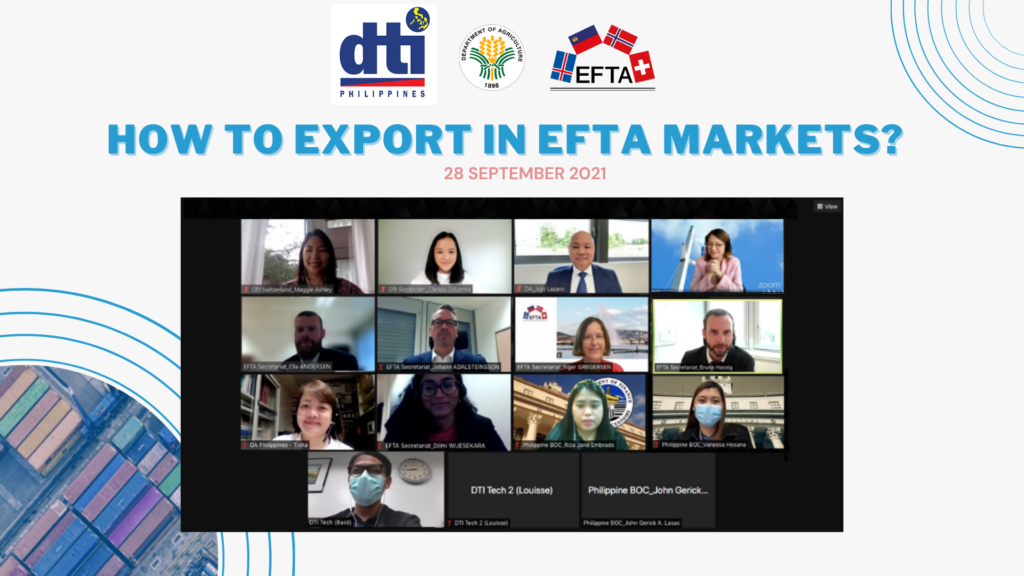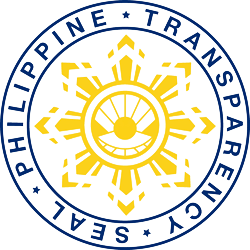
Local exporters looking for new and alternative markets may want to take advantage of the country’s free trade agreement (FTA) with the European Free Trade Association (EFTA) as part of their internationalization strategies, the intergovernmental association said during a webinar on 28 September.
The country’s FTA with the EFTA member countries of Iceland, Liechtenstein, Norway, and Switzerland kicked into effect in 2018 in what marks the Philippines’ second bilateral FTA after Japan.
“[W]e have embarked not only an FTA, which is a good framework for business, but also on a long journey of developing trade relations,” Krisztina Bende, trade relations division director of the EFTA Secretariat said during the opening remarks of “How to export in EFTA markets?” webinar.
Under the FTA, all industrial and fisheries tariff lines enjoy duty-free market access to EFTA, while key agricultural products, including frozen tuna, mackerel, canned pineapple, crude coconut oil, fresh and dried bananas, can benefit from significant tariff concessions. The agreement also liberalizes rules of origin, allowing certain exports to claim preferential treatment even if the inputs were imported.
Around 13% of EFTA’s imports come from its FTA partners including the Philippines, according to data cited by Ola Godø Andersen, senior officer at the EFTA Secretariat. While the current market share is small, the FTA sets a strong and rules-based framework to expand trade and investment relations and deepen the country’s foothold in Europe.
“If you look a little bit at the trade volume, import figures from the Philippines over the last ten years, we can see there’s a steady rise in import [values],” said Andersen.
In 2019, the first year fully covered by the FTA, imports to EFTA from the Philippines hit USD300-M with Switzerland commanding the largest share followed by Norway and Iceland. The top goods imported by EFTA from the Philippines in 2019 were electronics, machinery, along with marine products like fish and crustaceans.
While imports to EFTA fell in 2020 in part due to the pandemic, Andersen hopes that they will pick up over time. “We should see that we should get back on track now when businesses open up again. We have to keep that nice trajectory from before.”
From the Philippine side, exports to EFTA grew 6% YoY to USD461-M from USD434-M in 2019 despite the pandemic, Department of Trade and Industry (DTI) Undersecretary Ceferino S. Rodolfo previously said, in a development that suggests deepening ties.
On a per-country basis, imports from the Philippines to Switzerland have grown steadily and passed USD200-M in 2019. “Imports from the Philippines to Switzerland have increased significantly in the past years. It has not decreased thanks to the FTA and hopefully will increase more thanks to the FTA,” said Bruno Hässig, officer at the EFTA Secretariat.
While Philippine exporters can benefit from reduced tariffs in textiles, clothing, and vehicles, the significant opportunity lies mainly in bringing agricultural products to Switzerland, said Hässig. “The tariff on average is about 45% – this is very dissuasive when you want to import. But when we negotiate FTAs, we do make important concessions, especially for what we do not produce, and here, tropical products, mainly many fruits and nuts that, for example, the Philippines exports a lot.”
Norway and Iceland’s top imports from the Philippines are industrial goods like electronics, and machinery, according to Andersen and Johann Adalsteinsson of the EFTA Secretariat.
“The Philippines, traditionally, had a very positive trade balance with Iceland [from 2011 to 2020] that should normally [be] helped by the FTA,” said Adalsteinsson.
“If we look at between Norway and the Philippines, we can see that the balance of trade has shifted in the Philippines’ favor since 2016 about. It’s a nice trend that had a little peak in 2019 at the entry of force of the agreement and a slight turn down again due to COVID-19. We hope it turns up again, of course,” echoed Andersen.
In addition to pointing out the exporting opportunities for each market under the FTA, the speakers identified consumer preferences and retail trends to guide exporters who may be considering entering the EFTA markets.
The PH-EFTA FTA was also crafted to reaffirm the parties’ commitment to promoting trade and investment in a way that contributes to sustainable development, said Inger Gregersen, officer at the EFTA Secretariat. The specific commitments are anchored on obligations to ratify and implement the fundamental rights under the International Labour Organization and implement ratified international conventions on environmental protection, as well as encourage compliance with corporate social responsibility guidelines.
“When exporting to the EFTA states, please check that your products or services are produced sustainably in accordance with government regulations with regard to human rights, labor standards, and environmental regulations,” Gregersen told exporters and added that consumers in the EFTA States are looking for products that are produced sustainable.
Once exporters complete their due diligence and embed ESG standards into their operational framework, the next step they may want to consider is applying for approved exporter status with the Bureau of Customs. An approved exporter is authorized to make an origin declaration, a commercial document certifying that a good’s country of origin is the Philippines, which offers some form of preferential treatment under the FTA, explained Vanessa Hosana of the Customs Bureau.
The PH-EFTA FTA is the culmination of nearly ten years of engagements and negotiations that started when the EFTA countries indicated their interest to strike a deal in February 2009. It is also part of the Philippine strategy to forge stronger relations with non-traditional trading partners and gain a stronger foothold in the European market.
The webinar was organized by the Philippine Trade and Investment Centers in Bern and Stockholm and the Office of the Agriculture Attaché in Geneva with the support of the DTI-Export Marketing Bureau and the DTI-Bureau of International Trade Relations to raise awareness about the PH-EFTA FTA.
For more information about the Philippine free trade agreement with the European Free Trade Association, you may read this briefer from DTI and EFTA. To learn more about the requirements for the approved exporter scheme, read this document from the Bureau of Customs. ♦
Date of Release: 11 October 2021



